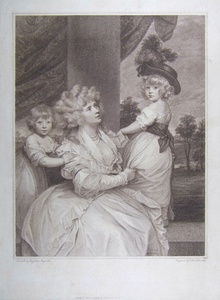| Method | Stipple |
| Artist | Francesco Bartolozzi after Sir Joshua Reynolds |
| Published | Publish'd Mar. 15. 1789, by F. Bartolozzi & Co |
| Dimensions | Image 292 x 230 mm, Sheet 359 x 267 mm |
| Notes |
A group portrait of Jane, Countess of Harrington and her two sons, Lincoln and Charles, after Sir Joshua Reynolds (Mannings 1696). Jane is shown in three-quarter length and seated to the right, looking up at Charles, who stands whole-length on a stone ledge, looking to the front and wearing a large feathered hat. Jane's other son stands behind her to the left, with his right hand placed upon her shoulder. Behind the figures are a curtain and a column, and a landscape is set beyond at the right. Jane Stanhope, Countess of Harrington (née Fleming) (23 May 1755 – 3 February 1824) was the wife of Charles Stanhope, 3rd Earl of Harrington, and known as a beautiful and fashionable society hostess. She was a talented painter, and helped to launch the career of John Glover. She was well aquatinted with Sir Joshua Reynolds who painted two well known portraits of her. Francesco Bartolozzi (1727-1815) was an Italian engraver. The son of a goldsmith, Bartolozzi studied painting in Florence, trained as an engraver in Venice and began his career in Rome. In 1763 Richard Dalton, art dealer and librarian to George III, met him and invited him to London, promising him a post as engraver to the king. Bartolozzi moved to London the following year, and remained for thirty-five years. He executed numerous engravings for the King. He also made many engravings of paintings by Italian masters and by his friend, the painter Giovanni Cipriani. In 1768 Bartolozzi was the only engraver to become a founder member of the Royal Academy of Arts. He moved to Lisbon in 1802 as director of the National Academy. Sir Joshua Reynolds (1723-1792) was one of the most important figures of the eighteenth century art world. He was the first President of the Royal Academy and Britain's leading portrait painter. Through a series of lectures on the Discourses on Art at the Royal Academy he defined the style later known as the Grand Manner, an idealised Classical aesthetic. He had a profound impact on the theory and practice of art and helped to raise the status of portrait painting into the realm of fine art. A flamboyant socialite, Reynolds used his social contacts to promote himself and advance his career becoming one of the most prominent portrait painters of the period. Calabi & De Vesme 1216 iv/v, Hamilton 106 ii/iii Condition: Trimmed within the plate. Diagonal crease in upper right not affecting the image. Some slight surface abrasion upper margin not affecting image. |
| Framing | unmounted |
| Price | £200.00 |
| Stock ID | 40020 |

